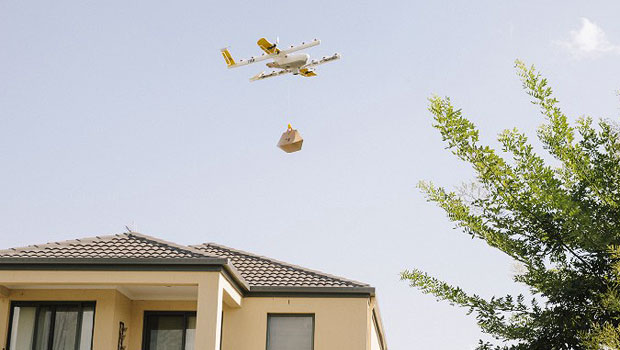The Federal Aviation Administration has given its first air drone delivery certification in the United States to Alphabet’s Wing Aviation, paving the way for the service to begin commercial package delivery in Blacksburg, Virginia.
“This is an important step forward for the safe testing and integration of drones into our economy,” said U.S. Department of Transportation Secretary Elaine Chao.
“Safety continues to be our No. 1 priority as this technology continues to develop and realize its full potential,” she added.
“This is a big sign that we’re finally starting to see drone delivery become a reality,” said Nicole France, principal analyst at Constellation Research.
“Others will undoubtedly follow suit,” she told TechNewsWorld. “It’s just a matter of time.”
Wing will reach out to businesses and communities in Virginia’s Blacksburg and Christiansburg areas to demonstrate the technology, and it plans to launch a delivery trial later this year.
“If the furor over electric scooters from the likes of Bird and Lime are any guide, this will garner no small amount of comment and need for policy guidelines,” France remarked.
A Charter Airline, Not a Drone Service
Wing Aviation was certified under the rules for charter airlines rather than under rules governing drone operation as laid out in FAA regulations Part 107, CEO James Burgess said.
Part 107 allows drones to be flown for hire only if flights are within a ground operator’s eyesight. Automated flights over longer distances are allowed only if they are demonstrations with no fees involved.
Wing needed to become a full fledged air carrier to operate over longer ranges and to charge for the service, Burgess said.
“It makes sense that they’d fall under the same category as charter services, Part 135,” said Constellation’s France, who holds a private pilot license.
Wing Aviation probably will have to adhere to all the relevant sections of Part 135, she said. “These regulations govern everything from required maintenance, documentation and training to the kind of cargo transported, operating limitations and equipment requirements.”
The key is to distinguish between private drone operations and commercial ones, France noted.”It’s ultimately about safety and applying the same standards to all commercial operators regardless of aircraft type.”
Coming Soon to a Community Near You
A drone is 25 percent as productive as a truck, but it costs six to 10 times less, according to OC&C Strategy Consultants.
Addressable demand for drone delivery will grow by 30-40 percent annually through 2023, OC&C has predicted. Sixty percent of B2B deliveries and 40 percent of B2C deliveries will be made by drone by 2023.
Early uses will include couriers for time-sensitive documents and delivery of vital medical supplies, according to OC&C. Future uses will include delivery of medical supplies to homebound consumers, critical parts to manufacturers, and use by companies in the fashion, grocery and electronics industries.
Commercial air drone delivery services will become commonplace in the U.S. within 24 months, Constellation Research principal analyst Ray Wang told TechNewsWorld in a previous discussion on this topic.
“Ray’s estimate is about right,” France said. “The FAA is not known for rushing new innovations into service and, especially given the flack it has received over its slow response to the Boeing 737-Max issue, they’re even less likely to be precocious now.”
The FAA has been criticized heavily in the U.S. and abroad for its slow response to Boeing 737-Max crashes earlier this year. Other countries grounded the plane without waiting for it to take action.
Obstacles to Drone Delivery Services
Legal issues will be the main impediments to airborne drone delivery services becoming commonplace, suggested Michael Jude, program manager at Stratecast/Frost & Sullivan.
“There will be lawsuits if a drone fails over a highway and crashes through a car window at speed, for example,” he told TechNewsWorld. “How do we settle liability then? What if the failure is due to malicious interference?”
A drone “is typically four unprotected propellers spinning at several thousand RPM,” Jude pointed out. “We’re talking about a flying lawn mower. Around kids. The trial lawyers are licking their lips over this.”
Further, other agencies might seek to regulate airborne drone services.
A drone is “a flying cellphone site,” Jude remarked. “Those things are highly regulated, because they could potentially interfere with other things or be interfered with, so the FCC’s involvement is critical.”
National security might be a factor as well.
“If a drone can deliver a pizza, it can deliver a block of C-4,” Jude pointed out. “If I were in any of the three-letter agencies, I would keep a close eye on drones.”
Weather also could be an impediment. Drones are weather-sensitive, which would limit their use, he said.
Amazon Grounded
Amazon, which introduced the idea of airborne drone delivery, has fallen by the wayside in the U.S. It was not invited to participate in the DoT’s UAS Integration Pilot Program and nothing has been heard of late about its Prime Air service.
Amazon’s restraint “tells me a lot,” Jude said. “With its resources, it could easily catch up. I think it will wait and see.”
























































Social Media
See all Social Media